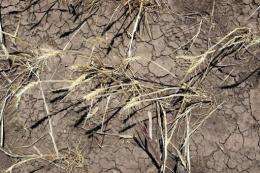Climate-driven heat peaks may shrink wheat crops

More intense heat waves due to global warming could diminish wheat crop yields around the world through premature ageing, according to a study published Sunday in Nature Climate Change.
Current projections based on computer models underestimate the extent to which hotter weather in the future will accelerate this process, the researchers warned.
Wheat is harvested in temperate zones on more than 220 million hectares (545 million acres), making it the most widely grown crop on Earth.
In some nations, the grain accounts for up to 50 percent of calorie intake and 20 percent of protein nutrition, according to the International Maize and Wheat Improvement Center (CIMMYT), near Mexico City.
In 2010, drought and wildfires in wheat-exporting Russia pushed world prices of the grain to two-year highs, underscoring the vulnerability of global supplies to weather- and climate-related disruptions.
Greenhouse experiments have shown that unseasonably high temperatures -- especially at the end of the growing season -- can cause senescence, the scientific term for accelerated ageing.
Excess heat beyond the plant's tolerance zone damages photosynthetic cells.
Fluctuations in wheat yields in India have also been attributed by farmers to temperature, most recently a heat wave in 2010 blamed for stunting plant productivity.

To further test these experiments and first-hand observations, a trio of researchers led by David Lobell of Stanford University sifted through nine years of satellite data for the Indo-Ganges Plains in northern India and then used statistical methods to isolate the effects of extreme heat on wheat.
They found that a 2.0 Celsius increase above long-term averages shortened the growing season by a critical nine days, reducing total yield by up to 20 percent.
"These results imply that warming presents an even greater challenge to wheat than implied by previous modelling studies, and that the effectiveness of adaptations will depend on how well they reduce crop sensitivity to very hot days," the researchers concluded.
The world's nations, under the UN Framework Convention on Climate Change (UNFCCC), have said that Earth's average temperature should not exceed the preindustrial benchmark by more than 2.0 C if dangerous warming impacts are to be avoided.
On current trends -- absent a major reduction in the emission of heat-trapping greenhouse gases -- the global thermometer could rise by twice as much, according to scientists.
"Even changes that were once considered rather extreme scenarios, such as a 4.0 Celsius (7.2 Fahrenheit) increase in global mean temperature, ... could happen as soon as the early 2060s," the study notes.
Wheat also faces another possibly climate-related threat: aggressive new strains of wheat rust disease have decimated up to 40 percent of harvests in some regions of north Africa, the Middle East and Central Asia.
Wheat rust is a fungal disease that attacks the stems, grains and especially the leaves of grains including wheat, barley and rye.
Global warming and increased variability of rainfall have weakened the plants even as these emerging rust strains have adapted to extreme temperatures not seen before, scientists say.
In November, the UN's climate science panel concluded that man-made climate change has boosted the frequency or intensity of heat waves, and that such extreme weather events are virtually certain to increase in the future.
If greenhouse gas emissions continue unabated, one-in-20-year heat peaks would likely occur every five years by about 2050, and every year or two by the end of the century, the Intergovernmental Panel on Climate Change (IPCC) said in a 1,000-page report.
(c) 2012 AFP

















